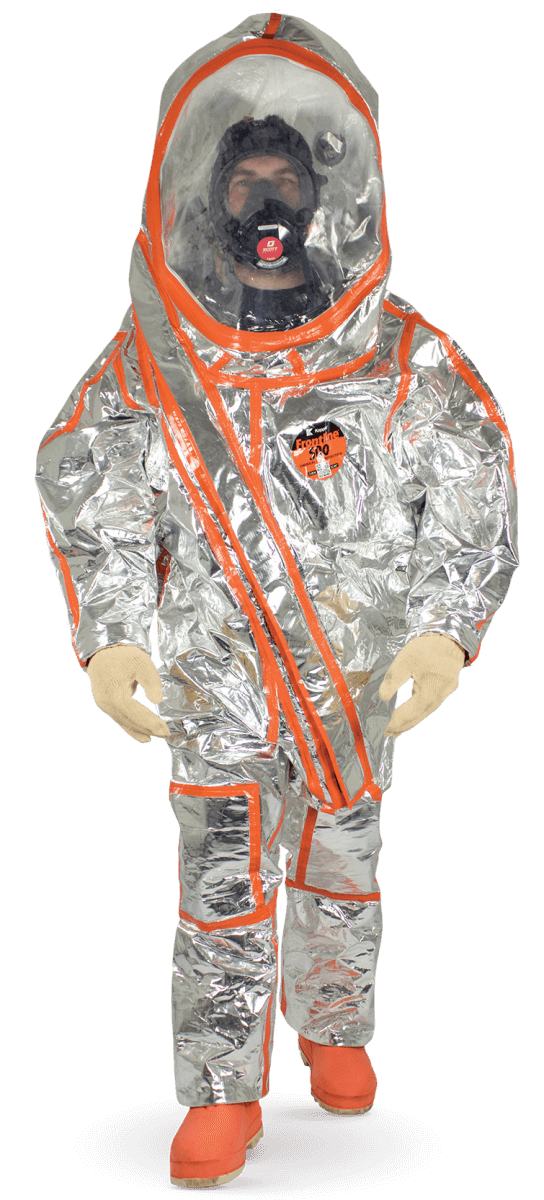NFPA 1990 (1991) Certified Apparel For Chemical Flash-Fire Protection.
Certified to NFPA 1990 (1991), Frontline® 500 offers proven three-way protection – broad chemical holdout, plus flame resistance and radiant heat protection for the additional hazards encountered in a chemical flash-fire. NFPA certification includes base plus Optional Flash Fire and Liquified Gas requirements. Like many Kappler garments, this is a ‘multi-use, single exposure’ suit. Frontline 500 provides excellent holdout for the ASTM F1001 battery and many additional chemicals.
To ensure optimal radiant heat protection, Kappler’s focus on user survivability included Pyroman Thermal Manikin testing in addition to the NFPA 1990 (1991) Chemical Flash Fire Option. Pyroman results for Frontline 500 indicated 0% body burn – a huge confidence factor when facing a chemical flash situation.
Frontline 500 Details
- Single suit provides proven three-way protection – chemical, flash-fire and radiant heat protection.
- Excellent “survivability” performance – 0% body burn in Pyroman Thermal Manikin testing.
- NFPA-certified ‘multi-use, single-exposure’ garment provides economical alternative to expensive FR reusables.
- AntiFog Expanded-View Visor System enhances responder safety.
- New patent-pending AntiFog Expanded-View Visor System.
- Removable Nomex/Leather Overgloves, plus field-replaceable 2N1® Glove System which eliminates inner glove inversion.
- Highly flexible 48” gas-tight AquaSeal® zipper facilitates easier donning and doffing.
- Fabric does not contain PFAS Chemistry. PFAS found in FEP lens at this time. Read more about PFAS.
- Typical Applications: Hazmat response and chemical handling with potential for chemical flash-fire.
FRONTLINE 500 CHEMICAL TEST DATA
| ASTM F1001 Chemical Test Battery* | |
|---|---|
| CHEMICAL | MINUTES |
| Acetone | >480 |
| Acetonitrile | >480 |
| Carbon Disulfide | >480 |
| Dichloromethane | 253 |
| Diethylamine | >480 |
| Dimethylformamide | >480 |
| Ethyl Acetate | >480 |
| n – Hexane | >480 |
| Methyl Alcohol | >480 |
| Nitrobenzene | >480 |
| Sodium Hydroxide | >480 |
| Sulfuric Acid | >480 |
| Tetrachloroethylene | >480 |
| Tetrahydrofuran | >480 |
| Toluene | >480 |
| Gases | |
| Ammonia Gas | >480 |
| 1,3 Butadiene Gas | >480 |
| Chlorine Gas | >480 |
| Ethylene Oxide Gas | >480 |
| Hydrogen Chloride Gas | >480 |
| Methyl Chloride Gas | >480 |
Frontline garments are designed for chemical flash fire protection FOR ESCAPE ONLY in the event of a chemical flash fire.
| Chemical Warfare Agent Data** | ||
|---|---|---|
| CHEMICAL AGENT | MINUTES | CRITERIA |
| Bis (2-chloroethyl) sulfide (Mustard:HD) | >480 | 4.0 ug/cm2 |
| Isopropyl methylfluorophosphonate (Sarin:GB) | >480 | 1.25 ug/cm2 |
| Chlorovinyl arsinedichloride (Lewisite:L) | >240 | 4.0 ug/cm2 |
| O-ethyl S-(2-diisopropylaminoethyl) methylphosphonothiolate (Nerve:VX) | >480 | 1.25 ug/cm2 |
FRONTLINE 500 HEAT, FLAME AND THERMAL TEST DATA
Frontline 500 has been tested for thermal protective performance (TPP) in accordance with ISO 17492, Clothing for Protection Against Heat and Flame, and showed a TPP value of 32.
Frontline 500 meets the requirements for flame resistance in accordance with ASTM F1358.
Frontline 500 meets requirements of NFPA 1990 (1991), including base requirements plus optional Flash-Fire and Liquified Gas requirements.
Frontline 500 has been tested in accordance with ASTM F 1930-00 Standard Test Method for Evaluation of Flame Resistant Clothing for Protection Against Flash Fire Simulations Using an Instrumented Manikin. The Frontline 500 ensemble garment indicated 0% body burn after a six-second burn test.
